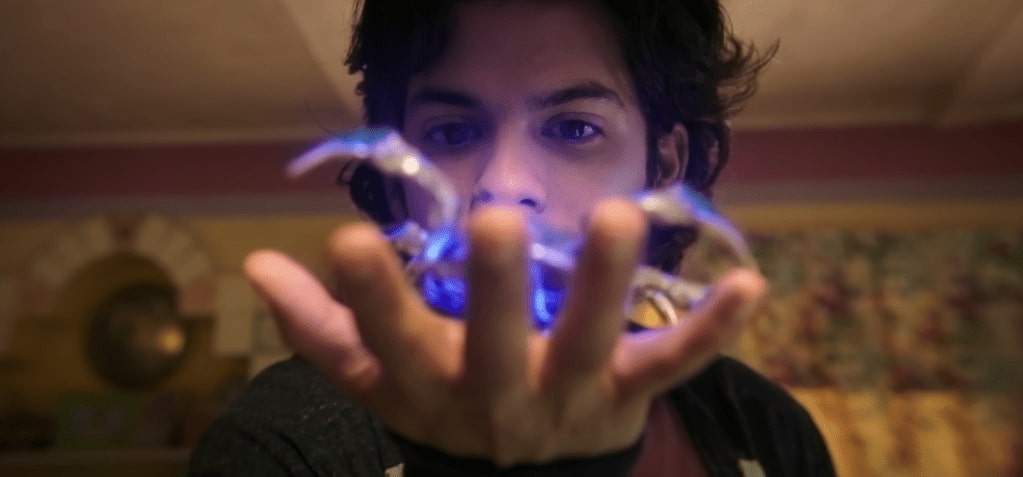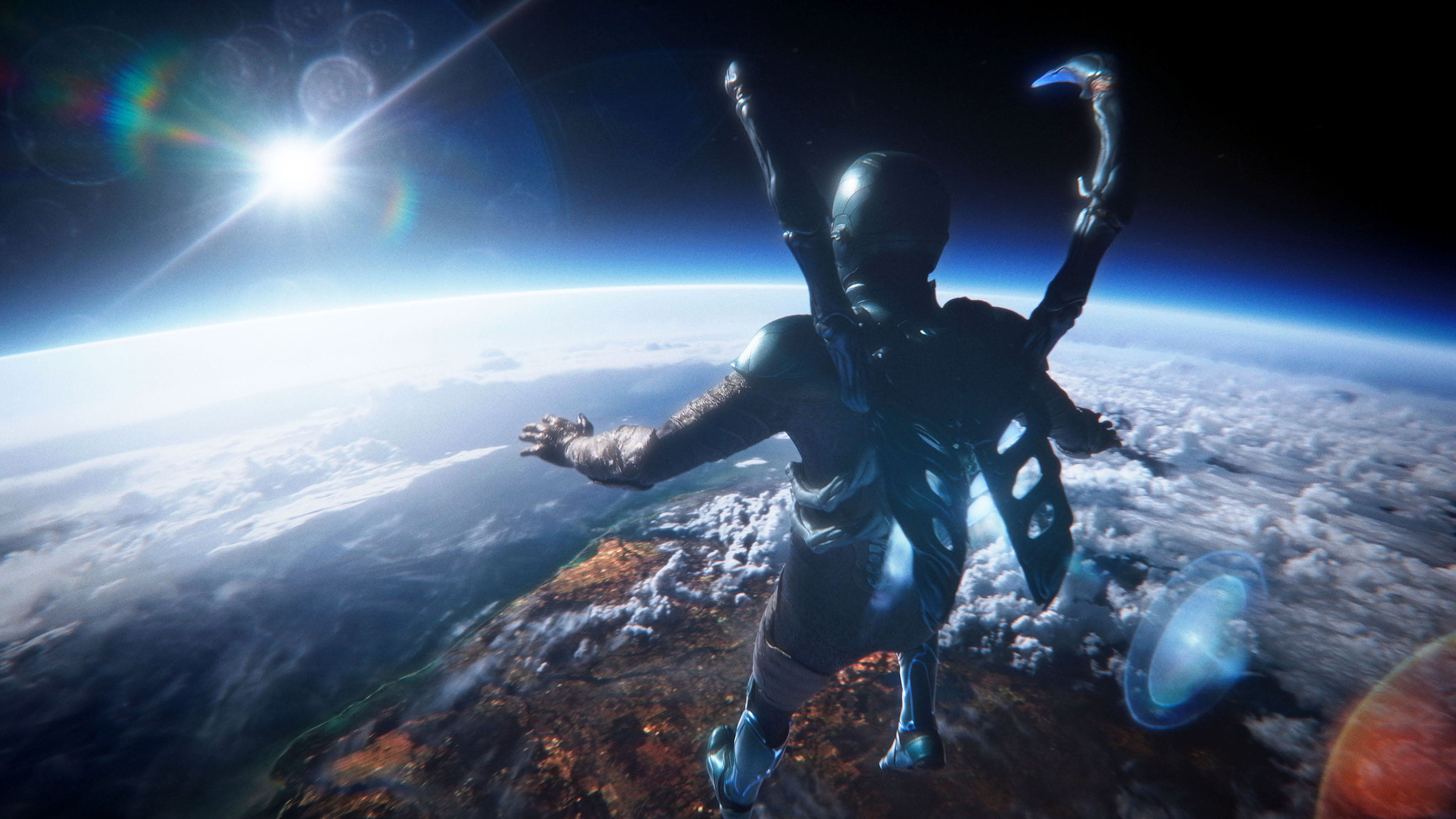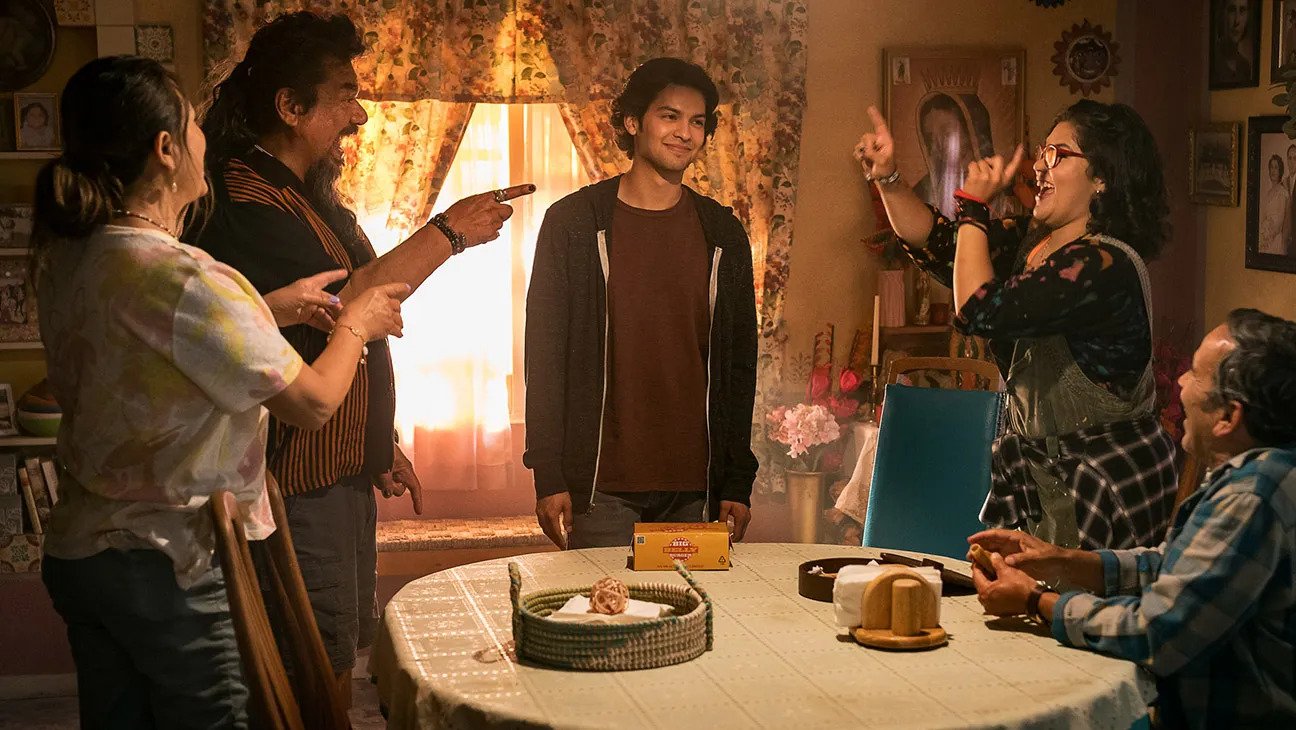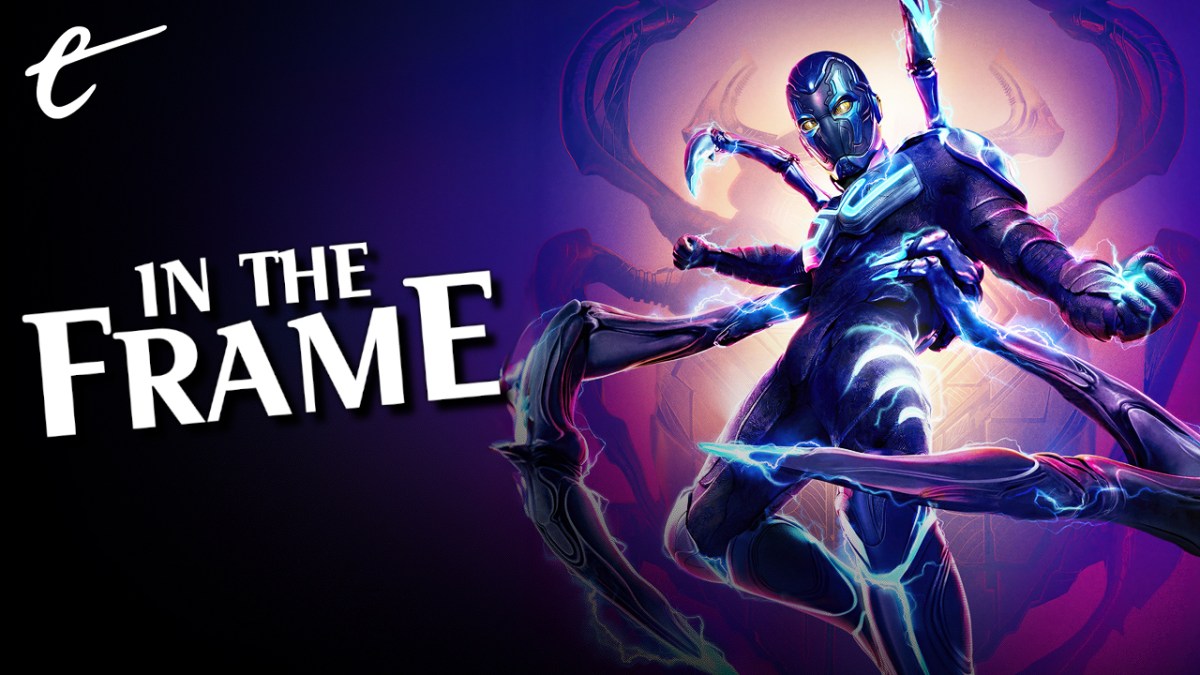This discussion of Blue Beetle, the latest DC film by Warner Bros., contains spoilers.
The most interesting thing about Ángel Manuel Soto’s Blue Beetle is how small it feels.
Part of this is a result of the movie’s production history. Along with the infamously canceled Batgirl, Blue Beetle was originally conceived as a streaming rather than a theatrical release. However, Warner Bros. responded so strongly to Soto’s creative vision that, before the movie entered production, they decided that it would release in theaters. Watching the finished product, one feels the push and pull between these extremes, a modest coming-of-age story grappling against a bombastic blockbuster.
Despite the now obligatory pre-release comparisons to Christopher Nolan’s Dark Knight, Blue Beetle owes a lot to Jon Favreau’s Iron Man, the movie that launched the Marvel Cinematic Universe (the MCU) and one of the films that codified the modern superhero blockbuster. At this point, Warner Bros. have spent a decade trying and failing to emulate the approach that Marvel Studios have taken to the genre, leading to disastrous misfires like Joss Whedon’s Justice League.
Like Iron Man, Blue Beetle is about a massive multinational arms company, with much of the plot driven by the sinister machinations of the villainous billionaire Victoria Kord (Susan Sarandon). Like Iron Man, Blue Beetle focuses on a character who is granted an incredible artificial-intelligence-driven suit of armor, with Jaime Reyes (Xolo Maridueña) transformed into the eponymous superhero by a piece of technology stolen from inside Kord Enterprises.
Jaime’s efforts to master his suit evoke the joyous “driving with the top down” sequence from Iron Man, capturing the excitement of soaring through the sky. Much like Obadiah Stane (Jeff Bridges) in Iron Man, the evil Conrad Carapax (Raoul Max Trujillo) has his own suit of armor that is derived from that of the hero as part of a plan to mass-produce such instruments as part of the military-industrial complex. Even the casting of 1970s icon Sarandon evokes the use of Bridges in Iron Man.

This comparison is interesting, underscoring how far the genre has come from Iron Man. Upon its release in May 2008, Iron Man felt like a game-changer that pushed the limits of the superhero movie. More than a decade-and-a-half later, Blue Beetle hitting the same marks feels positively quaint. In a world where superhero movies look like The Flash, and where even the relatively personal Guardians of the Galaxy, Vol. 3 still has to blow up a planet, Blue Beetle feels modest.
This is quite deliberate. According to Soto, it was a conscious choice to keep the movie’s stakes relatively grounded. “He’s not going to save the world yet,” Soto promised in pre-release interviews, “he doesn’t deserve to yet.” While the movie is certainly action-packed, it’s refreshing to watch a superhero movie where the fate of the world — let alone the universe or reality — isn’t in the balance. This is another way it harks back to earlier genre entries like Iron Man or The Dark Knight.
Of course, this may also have been a pragmatic choice. The movie reportedly has a budget of $120 million. This is appreciably less than most of the summer’s big movies, notably Fast X ($340 million), Indiana Jones and the Dial of Destiny (“$300 million-plus”), Mission: Impossible – Dead Reckoning, Part One ($291 million), and The Flash ($220 million). As such, the film only has the budget to convincingly render so much spectacle. In the film’s first two-thirds, Blue Beetle carefully portions out its big action beats.
This is a responsible way to budget a feature film. Even just in terms of the industry’s financials, more of this summer’s movies should have been held to the same standards and restrictions. Blue Beetle’s pre-release tracking is not great, with estimates suggesting that the film may open to $30 million domestically. This is obviously not great, but even the worst case scenario will see Warner Bros. losing far less on Blue Beetle than the $200 million that that studio burnt on The Flash.
In the old days, a film like Blue Beetle could underperform at the box office and work its way to profitability on home media. Movies like The Princess Bride and Fight Club were able to eke their way into the black thanks to the sale of VHS and DVD copies, secondary markets downstream from theatrical distribution. Obviously, streaming makes that a lot harder, by cutting off those avenues. Either way, there is a budget crisis in Hollywood, and studios need to get them under control.

This year, for example, it’s entirely possible that Universal could lose money on Fast X, despite an impressive box office haul of $704 million. Indeed, the studio’s good fortune lies in the success of films with more reasonable budgets, like The Super Mario Bros. Movie ($1.3 billion on a $100 million budget), Oppenheimer ($648 million on a $100 million budget), M3gan ($180 million on a $12 million budget), Cocaine Bear ($87 million on a $30 million-ish budget), and even Knock at the Cabin ($55 million on a $20 million budget).
Even ignoring the financial arguments for keeping the budget on a film like Blue Beetle under control, the film benefits greatly from a more modest scale than many of its superhero contemporaries. Blue Beetle is at its strongest in its opening act, when it is content to spend time with Jaime and his family, giving the audience a sense of what life is like for the Reyes family in the fictional Palmera City. Instead of trying to numb the audience with spectacle, Blue Beetle charms them.
To be clear, Blue Beetle doesn’t look cheap. Soto worked with cinematographer Pawel Pogorzelski to give the film a rich neon-drenched color scheme, ensuring a distinct texture in this world where many blockbusters can look flat or uninspired. Although the film shot in Puerto Rico and El Paso, Maridueña describes Palmera City as having “the sound of a Miami and the look of a Los Angeles and the style of Barcelona.” It is as rooted in the 1980s as versions of Gotham City are in the 1970s.
Indeed, Blue Beetle loses something when the film inevitably scales upwards, both in terms of narrative and in terms of action. The movie’s first half is light on its feet and fun, largely relying on the easy charm of an engaging cast and a more grounded perspective than these films usually enjoy. Inevitably, the film cannot remain in that register. It finds itself drawn to become something much more in keeping with modern superhero blockbusters.
Part of this is mythology stuff that tends to clog up modern superhero franchises. Jaime Reyes was not the first character to carry the mantle of the Blue Beetle. He was the successor to Dan Garrett and Ted Kord. None of these characters were particularly popular or memorable. Outside of a supporting role in the cult classic Justice League International, Ted Kord is most notable as the inspiration for the character of Dan Dreiberg in Alan Moore and Dave Gibbons’ Watchmen.
There is no reason for Blue Beetle to clog up its narrative with references to Ted Kord, particularly since the movie decides not to cast the character in a mentor role similar to that played by Hank Pym (Michael Douglas) in Marvel’s Ant-Man movies. However, an extended portion of the second act has Jaime visiting Ted’s abandoned mansion, discovering his makeshift Kord Cave, getting exposition dumps about Ted from his uncle Rudy (George Lopez), and using his gadgets and gizmos.

It derails the movie, and it takes narrative real estate away from more interesting characters and plot beats. It has the effect of focusing a large part of the movie around an absent character to whom the audience has no real attachment. It feels so disconnected from the actual heart of the movie that casual viewers are more likely to wonder why Jaime’s family are suddenly flying around in a remodeled version of Dan Dreiberg’s (Patrick Wilson) “Owl Ship” from Zack Snyder’s Watchmen.
This focus on Ted Kord doesn’t just distract from Jaime. Susan Sarandon is a casting coup for Blue Beetle, an Academy-Award-winning actor who is perfectly capable of playing menacing, but the movie is more interested in Victoria’s relationship to her absent brother than in her as a character. Similarly, Jaime finds himself striking up a romantic relationship with Jenny Kord (Bruna Marquezine), who is more defined by her absent father than by her conflict with her tyrannical aunt.
The problems are compounded in the movie’s third act, which degenerates into fairly standard computer-generated nonsense, in which every supporting character gets some cool piece of superhero technology to employ against hordes of faceless goons on a remote island, as Jaime and Carapax knock each other through concrete walls in a direct lift of the similarly frustrating third act of Iron Man, albeit with even more explosions and even more computer-generated imagery.
As the scale escalates, it loses a lot of its humanity. The emotional climax of Blue Beetle hinges on the death of Jaime’s father, Alberto (Damián Alcázar), who has a heart attack when Victoria organizes a raid on the family’s house. Jaime and Alberto have a sweet conversation earlier in the movie, but Alberto is marginalized for extended portions of the second act, so Jaime can listen to Rudy exposit about Ted Kord. As a result, that beat doesn’t feel as clearly defined as it otherwise might.
Watching Blue Beetle, it is interesting to wonder whether this material was added — or even bulked up — when the decision was made to position the film as a potential theatrical franchise rather than as a modest streaming release. Certainly, the third act — with its remote location, anonymous henchmen, and copious computer-generated imagery — has the feel of a sequence deliberately fungible, a piece of gum that could be stretched or compacted depending on allotted budget.
It is a shame, because there is a lot to like in Blue Beetle, particularly when the film focuses on the humanity of its characters and the reality of their world. In its opening hour, Blue Beetle harks back to a simpler time for the superhero genre, when these stories were more intimate in scale and more personal in perspective. Indeed, a lot of the film’s charm comes from centering a community that is rarely the focus of these sorts of stories. Blue Beetle is strongest when it’s smallest.






Published: Aug 18, 2023 10:00 am